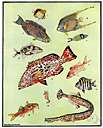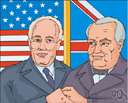al·lied
(ə-līd′, ăl′īd′)adj.
1. Joined or united in a close relationship: allied tribes.
2. Of a similar nature; related: city planning and allied studies.
3. Allied Of or relating to the Allies: the Allied invasion of southern Italy.
American Heritage® Dictionary of the English Language, Fifth Edition. Copyright © 2016 by Houghton Mifflin Harcourt Publishing Company. Published by Houghton Mifflin Harcourt Publishing Company. All rights reserved.
allied
(əˈlaɪd; ˈælaɪd)adj
1. joined, as by treaty, agreement, or marriage; united
2. of the same type or class; related
Allied
(ˈælaɪd)adj
(Historical Terms) of or relating to the Allies
Collins English Dictionary – Complete and Unabridged, 12th Edition 2014 © HarperCollins Publishers 1991, 1994, 1998, 2000, 2003, 2006, 2007, 2009, 2011, 2014
al•lied
(əˈlaɪd, ˈæl aɪd)adj.
1. joined by treaty, agreement, or common cause: allied nations.
2. related; kindred: allied species.
3. (cap.) of or pertaining to the Allies.
[1250–1300]
Random House Kernerman Webster's College Dictionary, © 2010 K Dictionaries Ltd. Copyright 2005, 1997, 1991 by Random House, Inc. All rights reserved.
ThesaurusAntonymsRelated WordsSynonymsLegend:
| Adj. | 1. |  allied - related by common characteristics or ancestry; "allied species"; "allied studies" allied - related by common characteristics or ancestry; "allied species"; "allied studies"related - connected by kinship, common origin, or marriage |
| 2. | Allied - of or relating to or denoting the Allies in World War II; "an Allied victory"; "the Allied armies" | |
| 3. | Allied - of or relating to or denoting the Allies in World War I; "an allied offensive"; "the Allied powers" | |
| 4. |  allied - united in a confederacy or league allied - united in a confederacy or league united - characterized by unity; being or joined into a single entity; "presented a united front" | |
| 5. |  allied - joined by treaty or agreement allied - joined by treaty or agreement aligned - brought into agreement or cooperation on the side of a faction, party, or cause |
Based on WordNet 3.0, Farlex clipart collection. © 2003-2012 Princeton University, Farlex Inc.
allied
adjective
1. united, joined, linked, related, married, joint, combined, bound, integrated, unified, affiliated, leagued, confederate, amalgamated, cooperating, in league, hand in glove (informal), in cahoots (U.S. informal) forces from three allied nations
2. connected, joined, linked, tied, related, associated, syndicated, affiliated, kindred doctors and other allied medical professionals
Collins Thesaurus of the English Language – Complete and Unabridged 2nd Edition. 2002 © HarperCollins Publishers 1995, 2002
allied
adjectiveConnected by or as if by kinship or common origin:
The American Heritage® Roget's Thesaurus. Copyright © 2013, 2014 by Houghton Mifflin Harcourt Publishing Company. Published by Houghton Mifflin Harcourt Publishing Company. All rights reserved.
Translations
مُتَحَالِف، مُتَّحِدمُرْتَبِط ، مُجْتَمِع مَعمُرْتَبِط بِ، مُشَابِه
příbuzný sspojeneckýspolu s
beslægtetforenet med
í bandalagi, bandalags-saman meî, ásamtskyldur
spojenecký
allied
[ˈælaɪd]A. ADJ
1. (Mil, Pol)
2. (= associated) [subjects, products, industries] → relacionado, afín
allied to sth → relacionado con algo, afín a algo
lectures on subjects allied to health → conferencias sobre temas relacionados con or afines a la salud
allied to sth → relacionado con algo, afín a algo
lectures on subjects allied to health → conferencias sobre temas relacionados con or afines a la salud
3. (= coupled) allied to or with sth → combinado con algo
his sense of humour allied to or with his clean-cut looks → su sentido del humor combinado con su cuidado aspecto
his sense of humour allied to or with his clean-cut looks → su sentido del humor combinado con su cuidado aspecto
B. CPD allied health professional N (US) profesional de la medicina o la enfermería que trabaja para una mutua
Collins Spanish Dictionary - Complete and Unabridged 8th Edition 2005 © William Collins Sons & Co. Ltd. 1971, 1988 © HarperCollins Publishers 1992, 1993, 1996, 1997, 2000, 2003, 2005
Collins English/French Electronic Resource. © HarperCollins Publishers 2005
allied
adj
(Mil, Pol: = affiliated) → verbunden; (for attack, defence etc) → verbündet, aliiert; allied to or with/against somebody/something → mit/gegen jdn/etw verbündet; the Allied forces → die Alliierten; an Allied attack → eine Offensive der Alliierten
(Biol, fig) → verwandt
Collins German Dictionary – Complete and Unabridged 7th Edition 2005. © William Collins Sons & Co. Ltd. 1980 © HarperCollins Publishers 1991, 1997, 1999, 2004, 2005, 2007
allied
[ˈælaɪd] adj → alleato/aCollins Italian Dictionary 1st Edition © HarperCollins Publishers 1995
ally
(əˈlai) verb to join by political agreement, marriage, friendship etc. Small countries must ally themselves with larger countries in order to survive.
(ˈӕlai) noun a state, person etc allied with another. The two countries were allies at that time.
alˈliance nounthe alliance between Britain and France; The three countries entered into an alliance.
ˈallied (ˈӕ-) adjective1. joined by political agreement or treaty. The allied forces entered the country.
2. (with with) together with; joined to. Her beauty allied with her intelligence made her a successful model.
3. (with to) related to; resembling. The ape is closely allied to man.
Kernerman English Multilingual Dictionary © 2006-2013 K Dictionaries Ltd.